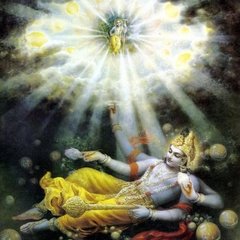Search the Community
Showing results for tags 'bliss'.
Found 6 results
-

How would you counter this hypothesis to the ‘Enlightenment’ idea?
galen_burnett posted a topic in General Discussion
So there is an argument that happiness only exists if it has suffering as a reference point. This is a conclusion that can be arrived at if you consider that the idea of everything existing in pairs and as opposites—the idea of Yin and Yang—is fundamental to existence; in this argument, happiness and suffering (I’ll say joy and pain hereafter as they’re shorter words) are not considered to be exceptions to this rule of Yin-Yang opposites, but rather are just another manifestation of Yin and Yang—albeit the most fundamental manifestation of Yin-Yang, as what experience could ever there be in Duality without shades of joy and pain? The argument is that joy can never be separated from pain because joy and pain define each other; they are a pair of opposites, like North and South; they refer to each other to give themselves meaning; without one the other ceases to exist. If all you ever saw was the colour blue then before long you would forget entirely what the other colours were, and the idea of colours, along with the colour blue itself, would then cease to be; considering, say, the greatest joy to be the colour blue in this analogy, the greatest pain as red, and all the degrees of pain and joy in-between—‘rather pleased’, ‘fine’, ‘bit off today’, ‘pretty annoyed’, etc.—being represented by the other colours. [*I know red and blue aren’t directly opposite each other on the colour-wheel, I guess cyan and orange are really, but it suffices for this post.] What’s more, in Eastern thought itself it’s considered that opposites give rise to each other in rotation: mess gives birth to cleanliness, which then becomes messy again; night to day, to night; pressure to expansion, closing into pressure once more; and so on. In this argument it is assumed that joy and pain behave in the same way: the most perfect heaven can become a hell of tedium and constriction if you stay there for too long; and the most violent hell can be inured to and got used to with enough time, until it even becomes a place of amusement and intrigue. Also, in this argument it is assumed that any and all levels of joy—even the very highest, most ultimate, degree of it imaginable—are still just ‘joy’, that all degrees of joy are as valid as each other; there is no splitting of hairs in this argument regarding the possibility of some greatest happiness existing ‘outside the bounds’ of ‘joy’—such a notion doesn’t make any sense from this point of view. I should note here that in this argument while all degrees of joy are considered as ‘valid’, it is accepted that not all beings will gain the same degree of joy from the same stimulus: a TV soap-opera may delight some people while be anathema to others, and meditation may be enormously relaxing and revitalising for some while incredible boring and dull for others; but this point is universally agreed upon by most, I think. There is the further matter of how ‘refined’ each degree of joy (or pain) is, and this actually comes relatively close to agreeing with the concept of an ultimate happiness actually, but stops short enough to still disagree with it considerably—but it is a tangent for another time. The notion of attainment of ‘perpetual-bliss’ is common throughout Eastern spiritual-practices and philosophy: it can be found in yoga, in Buddhist philosophy, and in Daoism (the attainment of Dao), going by various names (I’ve cited some of them in the tags of this post). It is the notion that, with diligence etc. , a person can transcend the plane of Duality and merge with the Non-Dual, whereat awaits perfect bliss and harmony for them, which they may abide in forever after. If we accept the argument that joy and pain are essentially dualistic opposites, then how can we sever them, throw out one, keep the other and then escape into Non-Duality with it? How can we smuggle a dualistic entity—i.e. joy—into the realm of Non-Duality? Wouldn’t Non-Duality be devoid of all experience whatsoever—blanker than blank—as all experiences in existence, including all forms of joy and pain, belong to Duality? even ‘experience’ itself can be thought of as being a dualistic opposite to ‘non-experience’ (though non-experience is impossible to comprehend). Rather than, say, Sahasraha (see Tantric yoga stuff) being an experience of the Non-Dual, isn’t it more apt to consider it as an experience of boundlessness, of formlessness, of unity, of mergence, of the infinite? which qualities are still within the realm of Duality, and therefore the Sahasraha experience itself could still be considered as a dualistic experience. In addition, if the happiness of Nirvana—said to be beyond the ‘illusory’ joys of Samsara—resides in the incomprehensible realm of the Non-Dual, then how can anything—including ‘illusory’ joys of Samsara—be compared to it? If it is beyond all things, how can those who tell of it liken it to anything at all, including to ‘illusory’ joy? How can they say “you know what ‘nice feelings’ are, right? Well Nirvana is ‘nice feelings’ times 100!” when Nirvana is supposed to be completely unlike anything that can be experienced in Duality, including pleasure and pain; so surely, then, there is no way to say that Nirvana is ‘nice’, as ‘nice’ is ‘dual’ and Nirvana ‘non-dual’; and yet, are we not in Eastern spiritual-practices encouraged to seek Nirvana for it being supposedly ‘nice’? So how would you counter this argument and uphold the notion of attainable ‘perpetual-bliss’? Have you met anyone who claimed to have attained it? If so, what made you believe them? If that person was indeed sincere in their claim to that experience, how did that person know themselves that they were not just experiencing a very long ‘high’? Also, how could that person have been operating in Duality if they had entered Non-Duality? If you believe in it after having read or heard about it, what that you have read or heard counters this argument? If both the experience itself and any attempt to explain the experience are beyond logic—due to ‘logic’ being tethered to Duality, and ‘ultimate attainment’ residing beyond Duality in Non-Duality—then how do you know about it in the first place and how are you able to talk about it or think about it—as knowledge, thought and speech all belong to the great despot of Duality—? If it is an intuition of yours that it is real, are you really willing to surrender your whole life in an attempt to attain something based on a gut-feeling? If you deduce its existence by extrapolation of your own life experiences—spiritual ones included—how do you do so?: what about your own experiences hints at the possible attainment of ‘perpetual-bliss’? There is a further argument against the notion of ‘perpetual-bliss’ which concerns itself with permanence-impermanence and with beginnings and ends and ‘ultimate attainments’, and though the argument in this post touches on this—through considering how opposites continually roll and transform into one another, and through questioning the true nature of an Enlightenment experience such as Sahasraha a couple paragraphs above—it’s divergent enough to leave it out here. As an aside, I am not debating here that great spiritual-experiences exist—they certainly do—; neither am I debating the immortality of the soul nor of consciousness—it certainly is—; neither am I denying enlightenment when considered as the notion of a progression through higher and higher levels of awareness, ability and intelligence; this is just an argument against the idea of the existence and attainment of ‘perpetual-bliss’.- 568 replies
-
- 3
-

-
- enlightenment
- samadhi
-
(and 8 more)
Tagged with:
-
No matter how auspicious an idea may appear as it is known by a knower from within the mind, identification with being anything in particular is essentially self-imposed limitation. The guru admonishes to leave concepts behind, to relinquish the identity of doership and acting, to be free of burdens not needful which may become to us as obstacles. Being is without doing. One can not help but simply Be oneself. All that must be done is then done rightly and naturally. Simply be as one has been, as one already is and as one will forever be. Be as you are, for the naturalness of this being that we are is that which makes the supposed becoming of anything in particular possible. Being this being, is to naturally abandon this or that identity. In this being, it's revealed that one is the knowing-ness of knowledge, the doing-ness of that which is done; the essence, the very being-ness of being itself. The Power of power. There's no being of this or that, there is only this-ness or that-ness, through and through. The heart of being, which is being, and beyond it. The Paramakash, so far removed from what the mind can imagine, that even the pure consciousness "I AM" seems to be an almost alien thing. From Paramakash, to Mahadakash: The gods and devas may possess names and forms, but the "light" of consciousness is completely attributeless. Without a body, it embodies all. That "light" which illuminates the mind as a reflection, is no more the mind or its contents than the Sun is equal to the daylight it provides. Lord Krishna: "By Me, in My unmanifested form, this entire universe is pervaded. All beings are in Me, but I am not in them. And yet everything that is created does not rest in Me. Behold My mystic opulence! Although I am the maintainer of all living entities and although I am everywhere, I am not a part of this cosmic manifestation, for My Self is the very source of creation." Innumerable states seem to appear upon or within this "light", along with the appearance of one(s) who appear(s) to traverse them. Eternally back and forth, seesawing up and down, the actions and inaction of the apparent many is reflected in the waking dream and deep sleep states. One can get comfortable in a dream of one's own making, lucid even, yet become mesmerized by the powers of awareness in the dream. One can become engrossed in the indulgences of physicality, unsatiated by desires of experiencing waking life to its presumed fullest potential. These states come and these states go. Yet there exists a "state" which never comes and never goes, beyond even the self-love that is undifferentiated bliss experienced in deep sleep. It is all there is. Conscious, unconscious, both conscious and unconscious, and Neither. The original being, experienceless, stateless in its state, in which all states and all experiences appear as if they were themselves dreams of a dreamer unknown.
-
I am really interested in knowing which books have you read, preferably short books that have put you into a state of bliss? Like for example, for me it was Ribhu Gita, chapter 26 as suggested by Ramana Maharshi. Thanks
-
At the end of my Sodarshan Chakra Kriya I started my Standing Meditation with the Microcosmic orbit. I immediately went into a state of Bliss that was many times more enjoyable than anything I have ever experienced before. It made all other sensations of sex, recreation, etc pale in comparison. I completed 14 minutes of standing and one 6 minute set of Tai Chi. A total of 20 minutes but, it seemed like 2. My Tai Chi was effortless. At the end of the Tai Chi set it just went away. I have noticed my meditations are better since then (three months ago) but, I have not experienced that state again Has anyone ever experienced anything like this? What are anyone's thoughts on this?
-
I know bliss isn't an end game; maybe its a bad goal. Still as a tool, a recreational one, it seems like a nice one to have in my pocket. I'd like to hear more from those who've attained it. What they did. Is it replicable? Easily turned on and off? Are there downsides? Personally I don't think I'll ever be the enlightened type. Just being happy, having a bit of bliss now and then sounds pretty good to me.
-

The ''Void''and the ''Diamond''(article that I found)
JinlianPai posted a topic in Daoist Discussion
http://www.chinabuddhismencyclopedia.com/en/index.php?title=The_%27%27Void%27%27and_the_%27%27Diamond-Thunderbolt%27%27 The link above answered some questions for me this is the first time that i read an article that combined thunderbolt naval hum in the heart, and dissolving into radiance all in one spot. The content from the article "The “Void” and the “Diamond-Thunderbolt” Tibetan lnitiatic Teachings The esoteric Tibetan teachings found here are taken from the Bde-Michog-Tantra (in Sanskrit: ShrIcakrasambhara), which was attributed to Yeshes-Senge, a monk of the gNas-rNying sect, published for the first time in 1919 with an introduction, a synopsis, and a partial English translation by the lama Kazi Dawa Samdup, in volume VII of the series of Tantrik Texts edited by Arthur Avalon. The excerpts published here correspond to pages 54-56 and 77-82 of this edition.’” These are two contemplative processes, the first aimed at detaching the mind, the second to free the senses, in order to attain samadhi in relation to various objects in a series that leads to the supreme state of shunyata. In both sets of instructions the reader will notice how the various images are connected to particular points in the human body on which the mental focus is directed. In the first set we begin with images of deities that are progressively interiorized and simplified, until the mind identifies with them and realizes their essence as rDorje. The term “rDorje” (in Sanskrit: vajra) has the double meaning of “diamond” and “thunderbolt.” It designates that which is hard, permanent, and indestructible like a diamond, and that which is sudden and irresistible like a thunderbolt. This is the basic principle of the magical resurrection. The supreme, triple secret of Tibetan Tantrism is said to be the “diamond-thunderbolt” of the mind, word, and body. There is an interesting relationship between vajra and shunyata in these doctrines. Shunyata is a term of Mahayana Buddhism. While in original Buddhism the concept of nirvana, which does not at all mean annihilation, is opposed to samsara, Mahayana Buddhism conceives samsara and nirvana as two coexistent aspects of a higher reality, or better, a higher state of consciousness, called shunyata. Shunyata literally means “emptiness,” “void.” It is the state of an absolute metaphysical freedom, a depth that can contain and will anything, without being altered or moved. Understood as ba sis and substance of all things (in Tibetan it is called Kungzhi), its identification to vajra shows it as the same radiant, incorruptible essence, consisting of pure activity, which the Hellenic traditions claimed the intelligible world or the world of “beings” was made of. In regard to the second group of contemplations, we need to add the following. The world that we know is only our world, a world of images that the mind projects outward. We mistake these images for reality and do not realize that we are constantly walking in circles around ourselves. In order to attain “knowledge” and the vision of the world of the real, we need to withdraw our consciousness from the images and to suspend the impulse whereby we project outward that which acts within our inner world, affected by desire. It is possible to withdraw and to concentrate the mind on a minute, fixed point and to receive in it the sensible impressions, until an ensuing transformation allows us to recognize things as they are in themselves, and no longer as shadows of phenomena. This is the meaning of samadhi. This should suffice as a general orientation for the second group of practices. They lead to a samadhi, first in regard to the various senses, and then, through this samadhi, to a higher type of samadhi, which is the realization of shunyata. Imagine in one’s navel a white eight-petaled lotus. In the center of this white lotus is a lunar disk. Upon this disk there are the personifications of the Diamond- Thunderbolt (rDorje-Sems-Pah-in Sanskrit: Vajra-sattva) and of His Spouse (rDorje-sNyems-ma) in close embrace, the Mantra “HUM” being in their hearts. Then imagine that rays of light issue from the “HUM” in all directions, vividly defining in the mind both the chief Devata (God) and the sur¬rounding space as the vessel, and the other Devatas and Beings occupying it as the vessel’s content. Fix the attention on this mental picture. Then imagine that the rays of light emitted from the “HUM” excite all these into activity. The process is like that of a magnet exciting movement of par¬ticles of iron dust (filings). Then, as the rays are gradually drawn back, imagine that all the exter¬nal space and its contents are drawn inward and absorbed into the form of the principal external Deity (Heruka and His consort). This process is lik¬ened to the absorption of mercury by cow dung. Next of the two principal Devatas the female is absorbed in the male, and the two into one face and two hands. This process is likened to that of a tortoise contracting its limbs. Then the consort of the external (god) Heruka is absorbed in the male and this into the Diamond- Thunderbolt in the navel. The consort of this Deity, too, sinks into the male. Then gradually the male figure itself sinks into the “HUM” in the heart and the “HUM” gradually resolves itself into the Bindu (dot). This process is likened to that of meteoric lights dissolving into each other. Then finally even the Bindu itself gradually becomes fainter and fainter until it fades away and disappears altogether, a process that is likened to salt dissolving in water. Such are the five principle processes of meditation illustrated by what are called the five radical similes. In the uncurtailed or unabridged process (rDzogsrim) the mental pictures (sNang-va) are like dresses, light rays, waves of water; but in them-selves and according to their own true nature they are like dancers, the sun, and the ocean.”° The final process of absorption and absence of all thoughts is likened to that of a bubble sinking back into water, or a rain-bow melting away into the skies. So the process is illustrated in various manners by various similes. Finally, the keeping of the mind in a state of tranquillity devoid of objects is called the process of concentration on the Diamond-Thunderbolt (rDorje-SemsdPah = shunyata). Assuming that he has attained to the stage of firm concentration of the mind and that he wishes to proceed further in the perfect or final stage (meditation on the formless), he should proceed thus:-Either in the morn¬ing (or any other time) let him take an easy position, cross-legged, and go through as a preliminary step the previously described meditation on Forms (bsKyed-rims). Let him imagine that the HUM inside his heart sheds out rays of light on all outer space and the objects therein. They are all gathered within the body. The Female Devata, too, is drawn in through the nostrils into one’s own heart. Having thought of oneself as the two-handed (Heruka), imagine the Guru on one’s head.” Put forth intense faith in him, and pray: “I beseech thee, cause pure samadhi to grow in my mind.” Then imagine on the (Tibetan) letter “A” a lunar disk, red and white, about the size of half of a pea inside one’s heart. Upon the lunar disk imagine a light-point (a zero or Bindu) about the size of a mustard seed that is the concentrated form of one’s mind. Fix the mind on that and regulate the breath gently (literally, “make it a gentle pair”). When one is well practiced, the mind is held and does not run astray, but remains fixed. Then one attains the blissful and clear samadhi. When one attains stability or firmness in that (samadhi), then transfer the imagination to another of the sense organs. Go through the preliminary step described above. For the actual method: imagine within the two pupils that there are two very fine bright white points, one in each eye. Close the eyes and imagine in your mind that the points are there. When the mind gets accustomed to that, then look on various objects... On being well practiced the point is constantly and vividly present to the mind’s eye. No matter on whatever object the eye may fall, samadhi is produced. Having achieved stability in that, draw in the point within the heart, and imagine that the latter gains great brilliancy and clearness, and keep the mind tranquil (literally, at a level: mNyamzbhag); this will produce samadhi of the most excellent kind, or the state of Tranquillity. After this, transfer the imagination to the ears. The preliminary steps are as described before. For the actual meditation:- Imagine two blue Points or Dots upon two lunar disks the size of half a pea inside each ear and meditate upon them, in a place free from noise. When you have succeeded in fixing the mind upon them, listen to sounds, at the same time keeping the mind fixed upon the two Points and not letting it stray from them. On being practiced in that, one attains vividness of the mind-picture and samadhi follows on hearing sound. When one has gained stability in this, withdraw the Points inside the heart and imagine that the Points have gained blazing brilliancy and vividness. From this excellent samadhi or Tranquility (state of mental level) is produced. Then transfer the imagination to the Nose. The preliminaries are the same as above:-Imagine a yellow Point on a lunar disk in the cavity of each nostril in a place free from any odor, and concentrate your mind on that. When the mind is fixed, smell various odors, keeping the mind fixed on the yellow Points, without letting the mind stray away. When one gets used to that, on the perception of odors there is produced samadhi. When firmness is gained in this (state), draw the Points into the heart. By this, brilliancy and vividness of the Point is produced and practice in this produces samadhi. Next transfer the imagination to the Tongue. Preliminaries the same as above:-Imagine a red Point on a lunar disk at the root of the tongue and meditate on it, without tasting any flavor. Concentrate your mind on it, do not let it stray. Then, when the mind is fixed on the Point, taste various flavors, keeping the mind concentrated on the Point. Then draw it inside the heart. When the Point attains brilliancy and vividness, samadhi is produced through the sense of taste. Then transfer one’s imagination to the (entire) body. Preliminaries the same as above. Either at the root of the secret parts (that is, the junction of the penis and the scrotum), or on your forehead, imagine a green Point on a lunar disk, and fix your mind on it without touching anything. When your mind has attained some degree of fixity on that spot, try concentration, touching various things and keeping the mind from straying. When vividness of the Point is obtained, practice until it is quite firm, then draw the Point in the place of touch into the Point within the heart, and meditate upon that, until great brilliance and vividness is obtained, which will produce Tranquillity or excellent samadhi.’” Then after that, transfer the imagination to the mind, which moves everywhere. Preliminaries same as above. Actual process:-Imagine a very small pink Point on the top of that already imagined to be within the heart. Try the meditation in a very quiet place at first. When you have succeeded in concentrating your mind, try the meditation in company where you are sure that some evil passions will be excited such as lust or the like. Then imagine that the chief passion-Moha”” (infatuation)-which accompanies all other evil passions is concentrated in it. Think that it is absorbed into a blue Point. Fix the mind on that. On getting accustomed in that (practice), passions will not arise; or should they do so, they are controlled by the mind. When one has attained firmness in that, sink the blue Point into the pink Point, and that into the white and red Point below it. The last sinks into the moon-disk, which in its turn is dissolved or disappears in the sky like a cloud (that has disappeared). Then there remains only Emptiness (shunyata or sTongpa), in which the mind is to be kept at a level. This will produce the profound tranquil state samadhi called ZhigNas (literally, “Resting-in-peace”). Then rising from the state of Tranquillity (samadhi), imagine again the lunar disks and the Points to be present or springing forth simultaneously: and that one’s ownself, too, is at once trans-formed into the Heruka (God). Regard external objects as being only visible and apparently true, but having no independent and absolute reality in themselves.” Meditating thus till each stage has shown its sign of perfection or proficiency, one at last attains proficiency or perfection in the whole, as a result of which one obtains profound Tranquillity, which is the realization of Shunyatd, which is bliss and clarity. Continuation in these practices produces the knowledge of the path (mThong-Lam), from is produced Buddha-hood. This is the stage of conferring grace and blessing (bdag-byndrlabs-pahi) on oneself, accompanied by Baja (Sabon).” Bums, Please post your thoughts and opinions.




